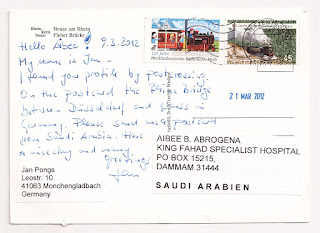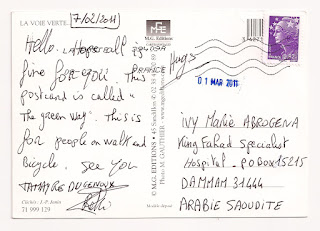Neuss is a city in North Rhine-Westphalia,Germany. It is located on the west bank of the Rhine opposite Düsseldorf. Neuss is the largest city within the Rhein-Kreis Neuss district and owes its prosperity to its location at the crossing of historic and modern trade routes. It is primarily known for its historic Roman sites, as well as the annual Neusser Bürger-Schützenfest. In 1984 Neuss celebrated 2000 years since its foundation. It therefore holds the title of "Germany's oldest city" alongside the city of Trier.
Travelling the world through postcards... Stamped postcards I received from postcrossing and direct swapping!
Thursday, June 4, 2015
Wednesday, June 3, 2015
Cafe Riquet, Leipzeg, Germany
Leipzig has been a trade city since at least the time of the Holy Roman Empire. The city sits at the intersection of the Via Regia and Via Imperii, two important Medieval trade routes. Leipzig was once one of the major European centers of learning and culture in fields such as music andpublishing. Leipzig became a major urban center within the German Democratic Republic (East Germany) after World War II, but its cultural and economic importance declined despite East Germany being the richest economy in the Soviet Bloc.
Koblenz, Germany
Koblenz, is a German city situated on both banks of the Rhine at its confluence with the Moselle, where the Deutsches Eck (German Corner) and its monument (Emperor William I on horseback) are situated. As Koblenz was one of the military posts established by Drusus about 8 BC, the city celebrated its 2000th anniversary in 1992.
Park Der Villa Hugel, Essex, Germany
The Villa Hugel in Essen district Bredeney in 1873 by Alfred Krupp built and is the former living quarters and state House of industrialist family Krupp .
The villa has 8,100 square meters on their living and usable area over 269 rooms and is located - in a prominent position above the Ruhr valley and the Baldeneysee - the 28 hectares large associated Hill Park .
Hamburg, Germany
Hamburg (Free and Hanseatic City of Hamburg), is the second largest city in Germany and the ninth largest city in the European Union. It is also the thirteenth largest German state. Its population is over 1.8 million people, and the Hamburg Metropolitan Region (including parts of the neighbouring Federal States of Lower Saxony and Schleswig-Holstein) has more than 5 million inhabitants. The port of Hamburg, on the river Elbe, is the second largest port in Europe (after the Port of Rotterdam) and tenth largest worldwide.
The official name reflects its history as a member of the medieval Hanseatic League, as a free imperial city of the Holy Roman Empire, a city-state, and one of the 16 states of Germany. Before the 1871 Unification of Germany, it was a fully sovereign state. Prior to the constitutional changes in 1919, the stringent civic republic was ruled by a class of hereditary grand burghers or Hanseaten.
Leipzig, Germany
Leipzig is a city in the federal state of Saxony, Germany. It has a population of 551,871 inhabitants (1,001,220 residents in the larger urban zone). Leipzig is located about 150 kilometers (93 miles) south of Berlin at the confluence of the White Elster, Pleisse, and Parthe rivers at the southerly end of the North German Plain. Leipzig has been a trade city since at least the time of the Holy Roman Empire. The city sits at the intersection of the Via Regia and Via Imperii, two important Medieval trade routes. Leipzig was once one of the major European centers of learning and culture in fields such as music and publishing. Leipzig became a major urban center within the German Democratic Republic (East Germany) after World War II, but its cultural and economic importance declined despite East Germany being the richest economy in the Soviet Bloc.
Leipzig later played a significant role in instigating the fall of communism in Eastern Europe, through events which took place in and around St. Nicholas Church. Since the reunification of Germany, Leipzig has undergone significant change with the restoration of some historical buildings, the demolition of others, and the development of a modern transport infrastructure. Leipzig today is an economic center, the most livable city in Germany, according to the GfK marketing research institution and has a prominent opera house and one of the most modern zoos in Europe. Leipzig is currently listed as Gamma World City.
Monaco, France
Monaco is a sovereign city-state and microstate, located on the French Riviera in Western Europe. France borders the country on three sides while the other side borders the Mediterranean Sea. Monaco has an area of 2.02 km2 (0.78 sq mi) and a population of 36,371; it is the second smallest and the second most densely populated country in the world. Monaco has a land border of 4.4 km (2.7 mi), a coastline of 4.1 km (2.5 mi), and a width that varies between 1,700 and 349 m (5,577 and 1,145 ft). The highest point in the country is a narrow pathway named Chemin des Révoires on the slopes of Mont Agel, in the Les Révoires Ward, which is 161 metres (528 feet) above sea level. Monaco's most populous Quartier is Monte Carlo and the most populous Ward is Larvotto/Bas Moulins. Throughland reclamation, Monaco's land mass has expanded by twenty percent. Monaco is a principality governed under a form of constitutional monarchy, with Prince Albert II as head of state. Although Prince Albert II is a constitutional monarch, he wields immense political power.
Sunset over Bassin d' Arcachon, France
The Arcachon Basin is a lagoon mésotidale located in the Landes de Gascogne , in Gironde , between the towns of La Teste-de-Buch south, Lege-Cap-Ferret in west and the delta of the Leyre east. He only stops the dunes 250 km from the Silver Coast , which stretches from the Gironde estuary to the river Adour . Unlike large lakes Landes , it is wide open to the Atlantic Ocean through the passes of the Arcachon basin and is a small sea inside 155 km² to tide high and 40 km² at low tide. We practice the ' oyster farming , fishing and boating. Since 8 June 2014, it houses the Marine Park of Arcachon .
Marseille, France received from UK
St. Charles borromeo cathedral, St. Ettiene, France
The Cathedral of Saint Charles Borromeo is a Roman Catholic cathedral church in Saint-Étienne, France. It has been the seat of the Bishop of Saint-Étienne since the foundation of the diocese on 26 December 1970. The church, dedicated to Saint Charles Borromeo, was constructed between 1912 and 1923 in a primitive neo-Gothic style, on a Latin cross ground plan with transept and triple nave, and a belltower on the west front. The building is 80 metres (260 ft) long, 30 metres (98 ft) wide and 17 metres (56 ft) from the centre of the roof vault to the ground. The organ in the choir dates from 1930, and there is another very imposing one by A. Durand from 1968. The building was however an excessively ambitious one right from the start, and remains unfinished: it was intended that there should be another three belltowers and a dome, besides quantities of external and internal decoration presently lacking.
This card is one of my first stamped postcards received in 2001.
Cote d' Azur, French Riviera, France received from Ukraine thru Postcrossing
 |
| UA-254915 |
Rouen Cathedral, France
 |
| FR-207943 |
Eiffel Tower at night
 |
| FR-170462 |
La Savoie map, France
Together with the Haute-Savoie, Savoie is one of the two departments of the historic region of Savoy that was annexed by France on June 14, 1860, following the signature of the Treaty of Turin on March 24, 1860. For history before 1860, details of the annexation, and modern regionalism, see Savoy.
Subscribe to:
Comments (Atom)






























